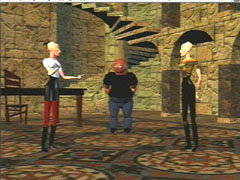

Courtesy NYU Media Research Lab
The use of VRML for theatrical type performance, both live and virtual is beginning to take off. Beginning with the now classic Floops from the folks at Protozoa, who used live motion capture to make that little bugger move characters are being brought to life in a variety of ways. The illustration for this article is from a Siggraph 95 paper by Ken Perlin and Athomas Goldberg about Improv. The Improv system being developed at NYU's Media Research Lab is truly remarkable. The system "provides tools to create actors that respond to users and to each other in real-time, with personalities and moods consistent with the author's goals and intentions." To be honest I was very skeptical about the system, I've heard of it but never got around to checking out what it can do. This is (with best California girl voice) like way cool dude! The characters have this uncanny ability to appear truly lifelike they react to the camera's position, to other actors, to various parameters one can play with. Check out the Improv site and play with them yourself. The PC demos are a little sparse but quite amazing. The use of VRML as the rendering engine is terrific because of the ubiquity VRML provides. I'll cover the Improv in more detail for a future feature article...but in the meantime check it out.
One big, (really big) theatrical project is VRML Dream. In the Artistic Statement about the project is described as:
Another major theater project, is The Virtual Theater project at Stanford. Run by Dr. Barbara Hayes-Roth a major Artificial Intelligence researcher the project's goals are:
There is no set story in this world. It is primarily a demonstration of our attempts at creating believable characters for simulated worlds. The Woggles have individual personalities, they display emotions, they engage in social behaviors (like fighting and playing follow-the-leader), and they react to their dynamic environment (including the user-controlled Woggle). They communicate by stylistic squashes and spins and they move by jumping. They can also move their eyes to watch what's going on around them.
Finally if you want to read some more theoretical/philosophical issues
surrounding issues of user interaction and storytelling in cyberspace check
out Computers
As Theatre by Brenda Laurel and Hamlet
on the Holodeck : The Future of Narrative in Cyberspace by Janet Murray.
Computers as Theatre provides a novel innovative perspective on human
computer interfaces and offers historical reasons for the emergence of
narrative virtual environments. Hamlet on the Holodeck is an innovative
look at storytelling in the context of the on-line world. Interactive
tales, stories as games and games as stories are all explored in
a fascinating look at the evolving world of cyberspace.
Let's remember to stop by the chat room..and the bboards open up on
Tuesday.
Hope you've enjoyed the show.